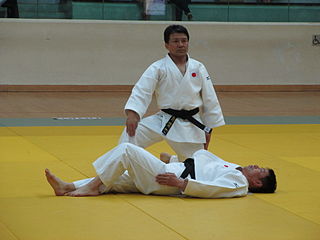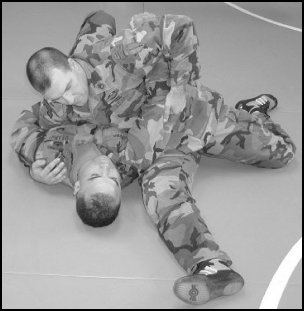Technique description
| | This section is empty. You can help by adding to it. (July 2010) |
| Ura Kesa Gatame | |
|---|---|
| Classification | Katame-waza |
| Sub classification | Osaekomi-waza |
| Technique name | |
| Rōmaji | Ura-Kesa-Gatame |
| Japanese | 裹袈裟固 |
| English | Back scarf hold |
Ura-Kesa-Gatame is one of the variations of Kuzure-Kesa-Gatame, a mat hold, listed in The Canon Of Judo.
| | This section is empty. You can help by adding to it. (July 2010) |
| | This section is empty. You can help by adding to it. (July 2010) |
| | This section is empty. You can help by adding to it. (July 2010) |
| | This section is empty. You can help by adding to it. (July 2010) |
Lists:
English aliases:
Similar:

In grappling, side control is a dominant ground grappling position where the top combatant is lying perpendicularly over the face-up bottom combatant in such a way that the legs are free and he or she exerts no control over the combatant on the bottom. The top combatant is referred to as having side control, and is in a stable position, with the other combatant pinned beneath them. From there the top combatant can proceed with elbows, knees, various submissions, or transition into a mounted position. It is high priority for the bottom combatant to sweep the top combatant or otherwise escape the position, for instance by entangling the opponent's free legs and trying to obtain the half guard or guard.

In combat sports, the north–south position is a ground grappling position where one combatant is supine, with the other combatant invertedly lying prone on top, normally with their head over the bottom combatant's chest. The north–south position is a dominant position, where the top combatant can apply effective strikes such as knee strikes to the head, or easily transition into various grappling holds or more dominant positions. Transitioning into side control can be done by first switching into a particular hold known as ushiro-kesa-gatame (後袈裟固) or reverse scarf hold, where the chest points to the side, and the opponent's arm is controlled similarly to kesa-gatame. The north–south choke is employed exclusively from this position.
Ushiro-kesa-gatame is an osaekomi-waza of judo. The hold works on the same basic principle as hon-kesa-gatame with the hold being applied across uke's chest with standard kesa-gatame leg positioning. What distinguishes ushiro-kesa-gatame from hon-kesa-gatame and kuzure-kesa-gatame is that tori's body positioning is reversed, facing towards uke's feet.

Katame no Kata is one of the two Randori-no-kata of Kodokan Judo. It is intended as an illustration of the various concepts of katame-waza that exist in judo, and is used both as a training method and as a demonstration of understanding.

Kesa-Gatame (袈裟固) is one of the seven mat holds, Osaekomi-waza, of Kodokan Judo. In grappling terms, it is categorized as a side control hold. It is commonly referred to as scarfhold in English due to erroneous translation from Japanese. The 'scarf' in scarfhold is in reference not to a western neck scarf but instead to a Bhuddist Monk's sash worn from the left shoulder towards the right hip which was formerly known as 'kesa'.

Kuzure-Kesa-Gatame (崩袈裟固) is one of the seven mat holds, Osaekomi-waza, of Kodokan Judo. In grappling terms, it is categorized as a side control hold.

Kata-Gatame (肩固) is one of the seven mat holds, Osaekomi-waza, of Kodokan Judo. It is also one of the 25 techniques of Danzan Ryu's constriction arts, Shimete, list. In grappling terms, it is categorized as a side control hold. Primarily used as a hold down in Judo, it is mostly used as a choke in Jiu-Jitsu and mixed martial arts. WWE wrestler Braun Strowman and former Impact Wrestling Superstar, Samuel Shaw use this move as their finishing maneuver.

Kuzure-Kami-Shiho-Gatame (崩上四方固) is one of the seven mat holds, Osaekomi-waza, of Kodokan Judo, a variation of Kami shiho gatame. In grappling terms, it is categorized as a north-south hold.

Ude-Hishigi-Ude-Gatame (腕挫腕固) is one of the official 29 grappling techniques of Kodokan Judo. It is one of the nine joint techniques of the Kansetsu-waza list, one of the three grappling lists in Judo's

Ude-Hishigi-Sankaku-Gatame (腕挫三角固), also referred to as Ao muke gata ude hishigi (背中方腕挫) in the Canon Of Judo, is one of the official 29 grappling techniques of Kodokan Judo. It is one of the nine joint techniques of the Kansetsu-waza list, one of the three grappling lists in Judo's Katame-waza, enumerating 29 grappling techniques, and is also demonstrated by Kyuzo Mifune in the video The Essence of Judo.

Koshi Guruma (腰車), is one of the original 40 throws of Judo as developed by Jigoro Kano. It belongs to the second group,
Ushiro-Kesa-Gatame is one of the variations of Kesa-Gatame, a mat hold, listed in The Canon Of Judo.
Rachida Ouerdane is an Algerian judoka, who competed in the middleweight category. She is a three-time champion at the African Judo Championships, and a two-time medalist at the Mediterranean Games. She also won a gold medal in the same division at the 2007 All-Africa Games in Algiers.
Nesria Al-Jelassi is a Tunisian judoka, who played for the lightweight category. She is a two-time Tunisian judo champion, and a four-time medalist for the 57 and 63 kg classes at the African Judo Championships. She also won a gold medal at the 2011 All-Africa Games in Maputo, Mozambique, and silver at the 2007 All-Africa Games in Algiers, Algeria.
Sanna Maria Karolin Askelöf is a Swedish judoka who competed in the women's half-lightweight category. Being raised by a Swedish father and a Norwegian mother and holding a dual citizenship to compete internationally, Askelof held five national senior titles in her own division, picked up a total of twenty-eight medals in her career, and represented her paternal nation Sweden in the 52-kg class at the 2004 Summer Olympics. Throughout most of her sporting career until 2009, Askelof trained as a full-fledged member of the judo squad for Södra Sports Club in Farsta.
Erdene-Ochiryn Dolgormaa is a Mongolian judoka, who competed in the women's heavyweight category. She picked up five medals in her career, including a bronze from the 2002 Asian Games in Busan, and represented her nation Mongolia in the over-78 kg division at the 2004 Summer Olympics.
Elina Vavailagi Nasaudrodro is a Fijian judoka who competed in the women's lightweight category. She picked up a bronze medal in the 57-kg division at the 2004 Oceania Judo Championships in Noumea, New Caledonia, and represented her nation Fiji, as an eighteen-year-old teen, at the 2004 Summer Olympics.